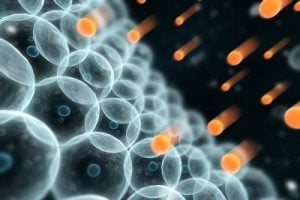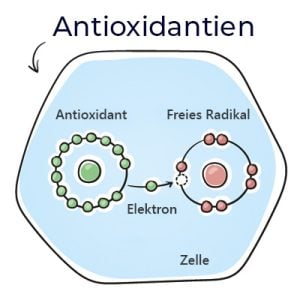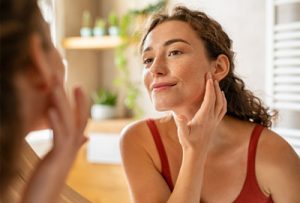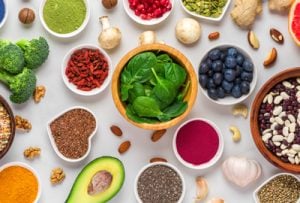
Every person is unique!
Our experienced team will be happy to advise you in detail and free of charge on all matters relating to your health. Book your consultation appointment now:
Antioxidants, OPC and Q10
March 3, 2022
Dr. Dorothee Bös et al.
Scientific research has clearly shown that free radicals contribute to the damage and destruction of cells and tissues. Many health problems and also the signs of premature aging are a result of cell damage. Therefore, it is of utmost importance to protect oneself from an excess of free radicals with the help of antioxidants.
Free radicals are now associated with the development of over 50 diseases: atherosclerosis, heart attacks, diabetes, rheumatism, allergies, immune deficiency, autoimmune diseases, cancer and many others. Especially in inflammatory and degenerative diseases, free radicals play a crucial role.
Free radicals are increasingly produced by modern living conditions. Environmental pollution, alcohol, smoking (active and passive), certain drugs such as cytostatics or the contraceptive pill, radiation exposure, tumor diseases, physical overexertion, stress, additives in food and many other factors promote their formation. As a result, oxidative stress occurs.
Formation and effect of free radicals
The organism needs oxygen to produce energy. In the course of these processes, highly reactive, aggressive intermediates called free radicals are formed. Free radicals are the smallest particles of chemical compounds that have unpaired electrons. Since they strive to regain an even number of electrons, they are particularly reactive and snatch individual electrons from other molecules. Oxidation occurs. On the one hand, free radicals are constantly produced in the body due to normal metabolic processes, but on the other hand, they are also produced by external influences. Some of them can be avoided by a healthy lifestyle, others the human being is more or less helplessly at the mercy of.
 Free radicals prefer to attack proteins and fats that are essential for life. But they can also attack the inside of the cell and our cell membranes. Particularly sensitive to such attacks are the delicate membranes of human cells, which can easily be destroyed by such attacks. The cells damaged in this way either die or change. Over the course of a lifetime, these defects accumulate; diseases develop or premature aging occurs. Any tissue and organ of the body can be affected.
Free radicals prefer to attack proteins and fats that are essential for life. But they can also attack the inside of the cell and our cell membranes. Particularly sensitive to such attacks are the delicate membranes of human cells, which can easily be destroyed by such attacks. The cells damaged in this way either die or change. Over the course of a lifetime, these defects accumulate; diseases develop or premature aging occurs. Any tissue and organ of the body can be affected.
Antioxidants meaning
Free radicals damage the body only when they get out of hand and the organism can no longer control them. The healthy body has protective mechanisms – so-called antioxidants.  With their help, it can neutralize the reactive substances and thus protect itself from an excess of free radicals. Antioxidants include, for example, enzymes such as superoxide dismutase (SOD), the glutathione system or vitamins. The antioxidants are able to give up an electron without becoming a free radical themselves. Thus, the antioxidants serve the free radicals with electrons and make them harmless. Their aggressiveness is slowed down and the oxidation of cell structures and protein molecules is prevented. Antioxidants thus act like protective substances and are radical scavengers.
With their help, it can neutralize the reactive substances and thus protect itself from an excess of free radicals. Antioxidants include, for example, enzymes such as superoxide dismutase (SOD), the glutathione system or vitamins. The antioxidants are able to give up an electron without becoming a free radical themselves. Thus, the antioxidants serve the free radicals with electrons and make them harmless. Their aggressiveness is slowed down and the oxidation of cell structures and protein molecules is prevented. Antioxidants thus act like protective substances and are radical scavengers.

Every person is unique!
Our experienced team will be happy to advise you in detail and free of charge on all matters relating to your health.
Where do antioxidants occur?
A balanced diet with plenty of fruits, vegetables and mushrooms already provides us with many antioxidants. For example, with vitamins A, B, C and E, beta-carotene, lycopene, anthocyanins and allicin. In addition, with the secondary plant substances (flavonoids) we consume substances that regenerate our radical scavengers in the body. The various antioxidants complement and potentiate each other. If you supplement them, you should ideally take them in the same combination as nature offers us. The trace elements – such as zinc, copper and selenium – are very important for the activity of some enzymes involved in antioxidant processes. Scientists at Penn State University have found that mushrooms are so rich in antioxidants that they outperform many other foods at it.
Put simply, antioxidants act as protective substances and radical scavengers. OPC (oligomeric proanthocyanidins) from the group of flavanols is considered one of the most effective antioxidants of all. OPC is contained in large quantities in grape seeds. It was discovered by the Frenchman Prof. Dr. Jack Arthur Masquelier when he examined peanuts in the early 1940s. He found a colorless substance with a strong protective effect on blood vessels. In 1995, Masquelier was able to provide evidence that the same substance is also found in the skins and seeds of grapes and that these flavanols are superior to flavonoids in terms of their vasoprotective effect.
OPC has nearly 100 percent bioavailability, as it is detectable in the blood and distributed throughout the body within seconds of ingestion. It is water-soluble and reaches its highest concentration in the blood after only 45 minutes. After 72 hours it is completely consumed. Like vitamin C, it passes the blood-brain barrier and also exerts its effect in the brain. After only 24 hours, the resistance of the blood vessels has doubled. In the case of OPC from grape seeds, it must of course be taken into account that the grape seed powder must first be metabolized before the oligomeric proanthocyanidins (OPC) contained therein can develop the corresponding effect.
Multiple effects
OPC combines with proteins, especially with collagen. It thus causes a strengthening of blood vessels and improves blood circulation. Also, OPC provides stronger resilience, improvement of memory function, as well as slowing down the aging process. Furthermore, it develops a protective effect against caries and inflammation. OPC also strengthens the immune system and regulates histamine release. Thus, OPC is a good complement to medicinal mushrooms.
 Due to the special effect of OPC on collagen, there is also a positive influence on the appearance of the skin and connective tissue. The therapy of hormonal disorders, mental instability and chronic fatigue can also be effectively supported with antioxidants such as OPC. Furthermore, a direct antiviral (influenza and herpes viruses) and antibacterial effect by the oligomeric proanthocyanidins has been found.
Due to the special effect of OPC on collagen, there is also a positive influence on the appearance of the skin and connective tissue. The therapy of hormonal disorders, mental instability and chronic fatigue can also be effectively supported with antioxidants such as OPC. Furthermore, a direct antiviral (influenza and herpes viruses) and antibacterial effect by the oligomeric proanthocyanidins has been found.
OPC and natural vitamin C as an optimal combination
OPC behaves like the CO factor of natural vitamin C: it enhances its effect and thus activates collagen production in particular. OPC and natural vitamin C act synergistically. This means that they support and potentiate each other in their antioxidant effect. Therefore, a combined intake of natural vitamin C and OPC is recommended to ensure the optimal effect.
 OPC cannot be produced by the human body itself and must therefore, like vitamin C by the way, be taken in with food. However, we only consume an average of 3 mg of oligomeric proanthocyanidins per day with our food. However, a daily amount of 20 mg per 10 kg body weight is recommended. According to scientific studies, the antioxidant effect of OPC is even 50 times stronger than that of vitamin E.
OPC cannot be produced by the human body itself and must therefore, like vitamin C by the way, be taken in with food. However, we only consume an average of 3 mg of oligomeric proanthocyanidins per day with our food. However, a daily amount of 20 mg per 10 kg body weight is recommended. According to scientific studies, the antioxidant effect of OPC is even 50 times stronger than that of vitamin E.
OPC in combination with natural vitamin C can therefore be used for a variety of chronic diseases and is also extremely useful for the prophylaxis of later health problems.
OPC keeps young longer
Oxidative stress plays an essential role in aging. The combination of OPC and natural vitamin C thus forms an integral part of the body’s defenses and thus the long-term maintenance of health. Among other things, by supporting the vascular system including capillary functions, OPC can prevent or delay the onset of circulatory problems. Many neurodegenerative disorders such as Parkinson’s disease, Alzheimer’s disease and dementia can also be traced back to chronic exposure to oxidative stress.
Faster recovery after sports
During sports, the generation of oxygen free radicals increases. Antioxidants such as OPC can detoxify the peroxides produced during exercise.
Super Antioxidant
The level of the ORAC value (Oxygen Radical Absorbance Capacity) provides information about the antioxidant potential of a food. With values of over 100,000 μmol TE/100 g, experts also speak of “super antioxidants”. The recommendations for the basic daily supply are around 5,000 to 7,000 ORAC units. Therefore, when selecting OPC, make sure that whole grape seed is used as the basic substance, natural vitamin C is added, and the ORAC value of OPC is above 100,000 μmol TE/100 g.
Favorable: combination of OPC and coenzyme Q10
This combination is recommended to further enhance the antioxidant effect of OPC. Additionally, Q10 supports heart health and is important for energy production in the body.
Coenzyme Q10 is a vitamin-like substance that has significant antioxidant powers. It is also important for general health maintenance, as it is valuable for maintaining the vitality of tissues and organs. Q10 is found in all cells of the human body. The highest concentrations are found in the heart and liver. Normally, the Q10 requirement can be produced in the body itself. However, the Q10 content in the organism decreases with increasing age, with an unbalanced diet or when statins are taken. An additional intake of Q10 is then useful.
DO YOU HAVE ANY QUESTIONS?
We will gladly take time for you. In our free consultation we answer individually and personally all your health questions under:
